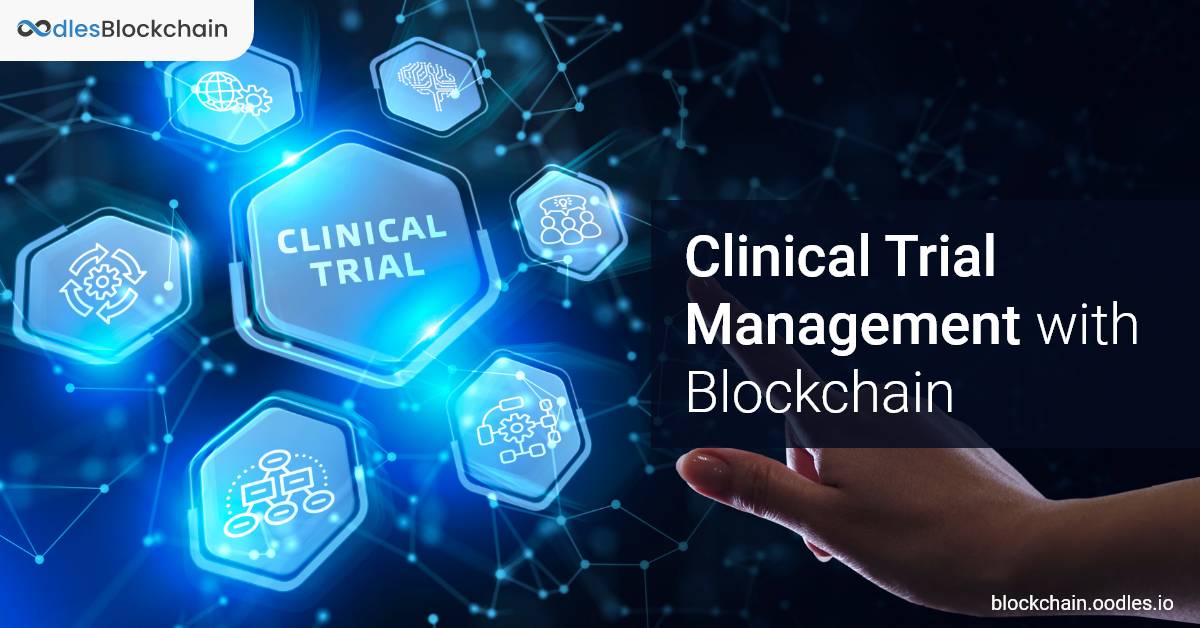-
This blog explains how blockchain application development may improve the workflow in clinical trial management. Further, you will show how pharmaceutical firms and other partners in clinical trials (such as CROs, regulatory agencies) can capture and store the data and research outcomes of subjects in a stable, distributed way and simplify and automate the workflow of clinical trials. Finally, we will analyze the implementation of a blockchain healthcare solution for Clinical Trial Management.
Clinical Trial Management | Challenges
Inefficient Management of Data
Access rights remain time-based as defined by database lock, blinding/unblinding of data. Also, various versions of knowledge come from a range of sources like external laboratories, CROs, and other manufacturers. Additionally, the rising globalization of clinical trials is compounding this issue. Data management happens in a spectrum of siloed structures, contributing to redundancy and complexity in obtaining the data needed.
Also, it is not easy to obtain data that makes it possible to address even easy clinical research and study questions. Time goes in extracting data from a multitude of outlets and cobbling reports together.
Entry to Data
Database structures that allow manual entry of data do not often connect subject data automatically to a holistic record. Since time goes in on combining data with a centralized archive, the investigator does not have the resources to analyze the data in real-time. Required regulatory procedures delay analysis because data usage does not get timely clearance. It involves inefficient strategic partnership management and research places and the involvement of multiple vendors in the studies.
Secure Exchange and Protection of Data
There is inefficient prevention of hacks, theft, classified information assault. Also, it involves tedious Verification of data by multi-party networks. Data sharing happens in an unregulated manner. There's no assurance that data sharing is compliant with federal and state laws must be assured.
Enrollment of Subject
Systems cannot hire, enroll, and retain eligible volunteers.
There is a lack of sufficient return on investment in the form of personal benefits for subjects, resulting in increased pressure on subjects involved in the research.Also, Read | Blockchain in Healthcare Data Management | Impact, Benefits, and Use Cases
Blockchain Technology
Blockchain is a distributed, shared ledger in which each document contains a connection to the next record, and cryptography maintains the database in sync. In a "block," data points remain clustered together. A reference to the previous block occurs in every new block. When new blocks get added to the database via connections to former blocks, we call it blockchain technology. When multiple members (or nodes) find a consensus and add a new block, they can read and write to the blockchain database. For the consensus mechanism, there are multiple algorithms/methods. In bitcoin, the most popular blockchain technology example, when 51 percent of the nodes accept and verify the new block, the consensus becomes achievable. For clinical trials, blockchain technology provides the following main features that are relevant.
Also, Read | Improving the Healthcare Infrastructure for Outbreaks like COVID-19 with Blockchain
Data Immutability
Data blocks remained joined together in a blockchain using hash functions. If the data in a block needs alteration, the hash function of future blocks will also modify and thus, change the final state of the whole blockchain technology application. The hash of the updated node would not match the hash of all unmodified nodes during the consensus process. In clinical trials, this property of the blockchain technology has tremendous use as no one can change verified clinical documents.
Decentralization
A single authority should not regulate a blockchain infrastructure. Distributed existence means that to participate in the network, multiple parties do not have to trust each other. For clinical trials and the pharmaceutical industry, some of the advantages of such a system are:
Replication of data
Information mirroring happens across multiple networks and organizations, meaning that each node has its data copy.
User empowerment and ownership
Decentralized structures enable respondents to retain their version of details. It means that consumers have the power over how and how they view their info.
Also, Read | Blockchain in Healthcare: Advantages, Use Cases, and Applications
Private or Permissioned Blockchain
An example of a shared blockchain network is Bitcoin, the most common blockchain. Public Blockchains are transparent, and everyone can enter, modify, interpret, and check transactions on the system. As the data is public, every person can run the node for the Bitcoin blockchain and download the whole ledger data and start participating in the network.
On the other side, private blockchain solutions run in a regulated environment. The nodes of the permitted blockchains are not public, and the network entry and participation are permissible only by pre-authorized or authorized individuals. A comparison would be that approved blockchains are like the intranet. Private blockchain solutions address three problems of public blockchains related to healthcare and clinical trial data management.
Privacy of Data
Data is not available on public nodes, unlike public blockchains, but rather on organizational nodes that are part of the network. Using permissioned blockchains, we can ensure that the system(s) can only allow entry by organizations/entities with specified permits as defined by a fixed protocol and execute only those network operations.
Regulation Compliant
Data privacy and security enforcement such as HIPAA or PIPEDA are accomplishable by permissioned blockchains as data remains stored only on allowed "nodes."
Cost and Speed
Heavy power use includes the management of a public blockchain database. It makes transacting both sluggish and costly on a decentralized blockchain network. With a private and registered blockchain, we can use inexpensive computer protocols to validate transactions. In contrast to standard public blockchains, this will make transactions on approved blockchains much quicker and considerably cheaper.
Also, Read | Enterprise Ethereum: A Platform for Private Blockchain Solutions
Blockchain's Benefits in Clinical Trial Management
Efficient Management of Data
Dynamic data access control- access privileges are dependent on time as specified by data blinding/unblinding, storage lock. In the same platform as pharmaceuticals and clinics, external labs, CROs, and other vendors will operate concurrently. The redundancy of data may become a thing of the past.
Regulatory bodies may operate on the same network - allowing them direct access to the data gathered for tracking and auditing. It is possible to validate data via multi-party networks.
Exchange of Details
The permissioned blockchain may exchange data in a managed manner. Via smart contracts, access privileges become enforceable.
Effective use of time and money for analysis data is encourageable by the simplicity of data exchange.Enrollment of Subject
It is possible to incentivize topic enrollment in an experiment. Subjects can pre-load their data onto the blockchain and can be paid by the network if/when they meet the inclusion/exclusion requirements for a trial.
Also, Read | Secure and Efficient Healthcare Data Sharing (POC) using Corda Blockchain
For more information in detail about applications of blockchain in improving the healthcare experience, connect with our blockchain development experts.

Our Offices
INDIA
Emaar Digital Greens, Sector 61,
Gurugram, Haryana
122011.
Welldone Tech Park,
Sector 48, Sohna road,
Gurugram, Haryana
122018.














